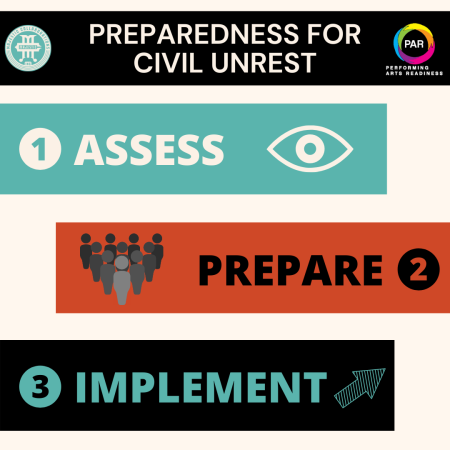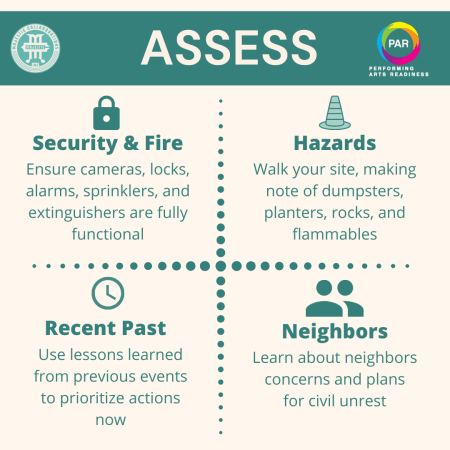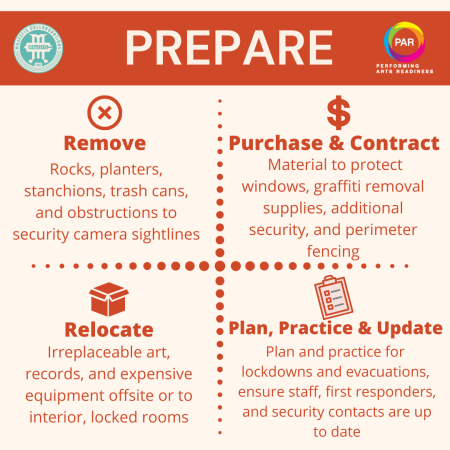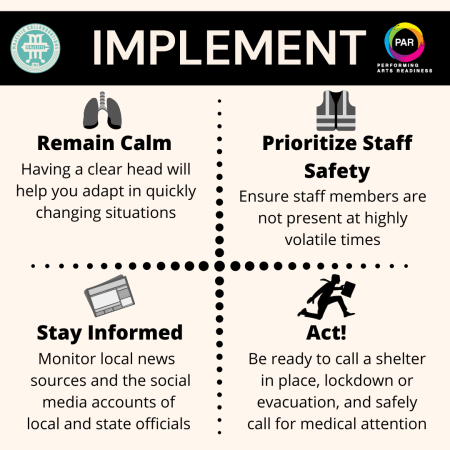Preparedness For Civil Unrest
For centuries arts and culture organizations have served as a community gathering space for people from all backgrounds. These spaces welcome diversity, they are a place to share with others our art—a piece of our souls. They are a place to be seen, to be heard, to be recognized—they are a beacon of light within our communities.
Our work at Majestic Collaborations seeks to empower communities to address environmental and humanitarian concerns with art, culture, design, and planning. As such we collaborate with others to design emergency action plans and disaster response plans. Our vision for our work is to provide these iconic cultural institutions the resources and tools to fortify against emergencies and provide for the safety of staff, volunteers, and the art and culture they shepherd.
In sharing this content we hope this acts as a guide for organizations to prepare their spaces in the event of hostilities that threaten spaces integral to our communities and the culture and people they represent. We hope these resources will help preserve the safe, transformative, enlightening, and joyful nature of these spaces so that organizations can continue to welcome people into community.
In the past year, some arts and cultural venues have experienced destructive acts to their building. These community centers have often been at the flash point of civil unrest that surround them, and sometimes targeted because of what they represent. We all share the values of civil rights and peaceful protest. With these values in mind, we wanted to put forward a quick and shareable resource about preparedness for your organization that helps provide guidance for what people who exert control over physical space can do to contribute to creating a safe environment for all.
Our preparedness plan focuses on three main steps–assess, prepare, implement—that you and your team can take to prepare in times of civil unrest. We hope these steps will act as a useful guide to ensure the safety of your staff and organization.

The first step is to assess your organization’s situation. Ask yourself what happened the last time there was civil unrest in your area and use those lessons to inform your actions. Ensure you conduct a site walk through, communicate with neighbors, locate and update important information, and secure or relocate your assets.
ASSESS
- Security & Fire: Ensure cameras, locks, alarms, sprinklers, and extinguishers are fully functional
- Hazards: Walk your site, making note of dumpsters, planters, rocks, and flammables
- Recent Past: Use lessons learned from previous events to prioritize actions now
- Neighbors: Learn about their concerns and plans for civil unrest

It is also important to engage in preventative measures to prepare your organization. Scheduling additional security for the day of a protest or election day is a good step in preparing your site. For the safety of your staff, communicate the plan to all staff members and ensure everyone is involved. Practice by sending test communications and running lockdown and evacuation drills.
PREPARE
- Remove: Remove projectiles such as rocks, planters, stanchions, trash cans, as well as obstructions to security camera sightlines
- Purchase & Contract: Plywood or window film to protect windows, graffiti removal supplies, additional security, and perimeter fencing
- Relocate: Irreplaceable art, records, and expensive equipment offsite or to interior, locked rooms
- Plan, Practice, & Update: Plan and practice for building lockdowns and evacuations, and ensure staff, first responders, and security contacts and protocols are up to date

Once you’ve created a plan, be ready to implement it. It’s better to have a plan in place for evacuation or lockdown that didn’t end up necessary than to have wished you had. Don’t be afraid to take precautions and prioritize the safety of your staff and organization.
IMPLEMENT
- Remain Calm: Having a clear head will help you adapt in quickly changing situations
- Prioritize Staff Safety: Ensure staff members are not present at highly volatile times
- Stay Informed: Monitor local news sources and the social media accounts of local and state officials
- Act!: Be ready to call a shelter in place, lockdown, or evacuation, and safely call for medical attention for people you observe in need

This content was produced for Majestic Collaborations by collaborators Elysia L. Smith and Sean Ferguson, with co-founder Matthew Kowal.
Please consider sharing this guide with venues and performing arts and cultural organizations. We welcome feedback and discussion. If you would like to get future updates on preparedness and skill sharing in arts and cultural communities please reach out to PAR@lyrasis.org. If you would like more information about The Art Of Mass Gatherings or Modifications & Virtualizations for Performing Arts please contact: communications@majesticcollaborations.com


